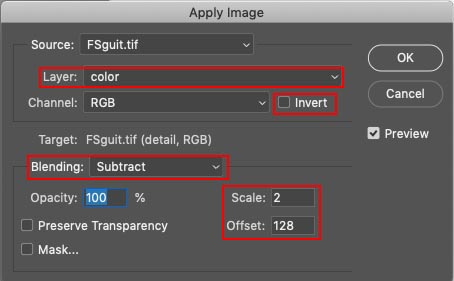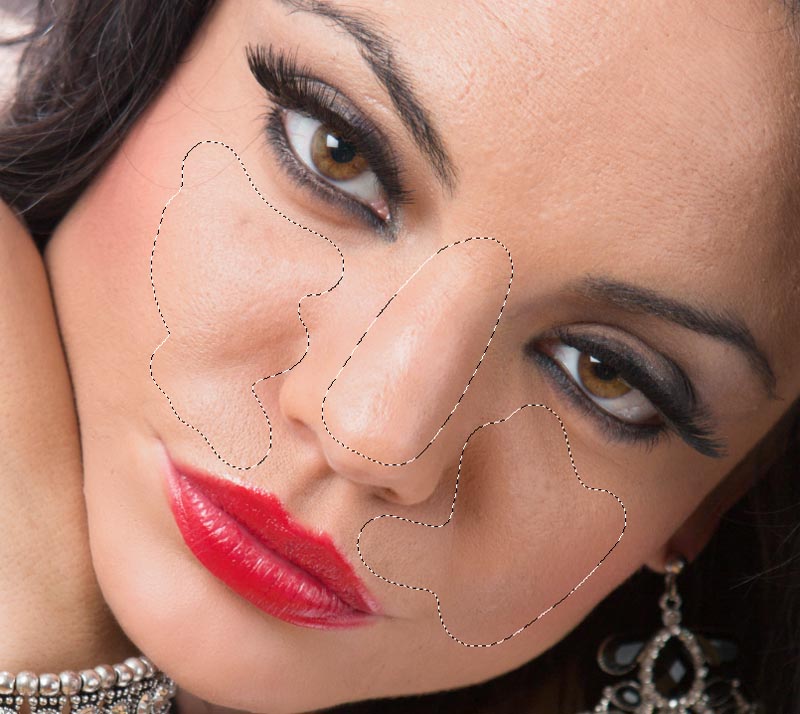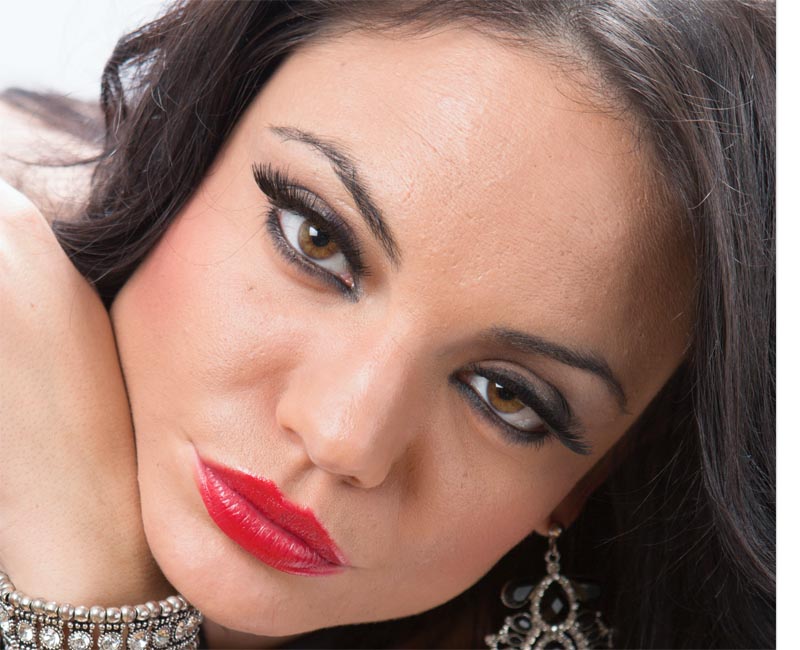How To Smooth Out Complexion In Photoshop
How to utilise Frequency Separation in Photoshop for shine silky skin without losing the pores.
Yous may accept heard the term Frequency Separation and wondered what it is. Or you have heard that all the loftier end retouchers are using this technique. Or, you may wonder how to smoothen out skin and remove blemishes and uneven coloring. In this Photoshop tutorial, Colin Smith explains what frequency separations is and how to utilize it without all the jargon. We pull back the veil and the mystery and lay it out in easy to follow steps.
© Colin Smith | Thanks to Lina for modeling for me in the photograph.
If you need a quick reference for the settings it's here:


The ethics of retouching
Retouching, often misnamed as "airbrushing" is the technique of smoothing out the skin in a way that is more than of an aesthetic than reality. The frequency separation technique I'm showing here is a requested mode often used in Glamour and Fashion photography. It'southward used in so-called "high end retouching" and non the kind of technique you would normally utilize on family portraits and corporate headshots. It's a fashion to transform skin into a detail await that is sometimes required in retouching. Some people absolutely love this await and others dislike it. Equally a rule of thumb, a good retouch is something that doesn't expect retouched. In certain situations, this isn't truthful, some styles require it to await retouched and "too" perfect is what'due south required. Its a great fashion to smoothen out skin and you can choose to employ it equally heavily or lightly every bit you lot wish. In this case we are going to a way that you might observe on the cover of a fashion magazine. At that place is a lot of argument effectually "airbrushing" and ethics. My goal hither is not to get into all of that, but rather, but present a tutorial on a technique that viewers take requested to acquire here at PhotoshopCAFE.
What is Frequency Separation
Frequency Separation is a bit of a mystery to those who oasis't used it and it may seem out of reach. My goal is to present it here in a fashion that anyone can start using and understanding the technique. I'1000 going to avoid jargon and make it equally simple as I maybe can. I hope y'all enjoy this tutorial.
Basically what nosotros are doing is taking a photo on a layer and splitting it into 2 layers. One layer will concur all the detail and none of the color. The second layer will contain all the colour, simply non the detail. This way nosotros can blur the color and even out blemishes without affecting any of the details such as pores in the skin and wrinkles on the color layer. On the detail layer we can remove acne, reduce wrinkles and other item blemishes without mudding up the colour and creating color spots. In a nutshell:
Frequency: High Frequency is the particular (remember treble). Low frequency is the underlying color and form (call back Bass).
Separation: Spilting, dividing etc. In this example splitting into 2 parts.
Ok, definition is over, time to practise it! There are 3 steps.
- 1. Setting it upwards
- 2. High Frequency removal of blemishes
- iii. Low frequency smoothing of colour
Allow's get started.

The Frequency Separation tutorial
Footstep 1. Setting up the Photoshop Layers
I have created an action that does these side by side few steps for you
Duplicate the layer 2x, so that there are 3 layers. Press Cmd/Ctrl+J twice.

Click, hold Shift and click on the side by side layer to select the 2 top layers.
Press Ctrl/Cmd+G to put them in a group. Name the Grouping FS

Name the pinnacle layer detail (This is the high frequency layer, but the tech name isn't needed)
Name the 2nd layer Color (LowFrequency. I won't use the term frequency again in this tutorial except for the name, because its merely jargon).

Pace 2. Doing the frequency Separation part
Plow off visibility on the item layer and choose the colour layer.
Choose Filter>Blur>Gaussian Blur

Movement the amount simply enough that the particular of the pores disappears. (4.2 hither – choose a higher number if needed) Click ok, this layer is ready.
Choose the detail layer

Choose Image>Apply Image
In the dialog box, cull the color layer from the layer driblet down. (we named it color in footstep i).

Under blending cull Subtract

Settings for Frequency Separation

Calibration 2, commencement 128
Make sure capsize is turned off and you should see a grayness prototype of only the details as shown

Click ok
You will yet see the gray prototype. Modify the blending mode to linear Low-cal and it should now look exactly like the original image.


The Frequency Separation layers are all set and ready for employ.
Note near 16 bit vs 8 bit (not a tutorial step): I like to suggest that these settings I nowadays work on both eight-bit and 16-bit images. I have seen different settings floating around for eight-flake vs 16-chip images. I have tried both sets of settings on both 8-fleck and xvi-bit images and I tin can't see the departure. I'k open to beingness corrected, simply please start with a 16-bit version of the image and apply both sets of settings. Then make an 8-fleck version and apply both sets of settings. There may exist a difference betwixt 8-bit and 16-bit images, but do the settings actually wait any unlike?
Retouching using Frequency Separation layers in Photoshop
Step three. Fixing the detail layer
At present it's time to do the retouching using the layers we have prepared. Starting with the particular layer selected.

Choose the healing brush (Or spot healing or clone stamp, whatever you prefer).

In the tool options at the top, choose Current Layer (This is important)

To utilize the Haeling brush, agree down Alt/Option and click on a good surface area near the blemish to sample information technology. Click with the healing bush on the expanse that you desire to cover upwards.
On the detail layer, practise your removal of things similar acne, blackheads etc, In this case, I didn't need to do much because Lina has nifty skin naturally.


Pace four. Fixing discoloration and uneven skin surface
This step is where the frequency Separation really kicks in.
Choose the color layer

Double click the quick mask to set up it upward. ![]()
Make sure Selected areas is called

Chose a brush (B) and click at the acme right to go to brush settings
![]()
Make sure a feathered brush is chosen with hardness turned all the fashion down to 0

Everyone I have seen do FS, uses the lasso tool, makes a pick and and then feathers information technology. (So experience costless to do that if you like) I prefer to use Quickmask, because I tin can paint on my choice and it already has a soft edge.
Choose Quick Mask (Q central) making sure foreground is set to blackness
![]()
Let's start with the chin. Arrange your brush size [ or ] keys. Paint on the chin, you should encounter a reddish color every bit shown. If not, press undo and become back over all the parts of stride 4 to see what stride you may have missed. (Besides watch my video at the top of the tutorial page, which y'all should have done anyway 😉 ).

Press Q to toggle to a pick. (Q toggles betwixt quick mask and a selection).

Allow's mistiness it. Choose Filter>Blur>Gaussian Blur

Cull an amount that causes everything to be smoothened out. In this case it's 12. If you want a more subtle effect, use a lower number. (normally I would utilise a lower number, but I want the difference to be clear for this tutorial)
Click OK
Press Cmd/Ctrl+D to deselect
See the earlier and later? This is the major part of Frequency separation. We are able to smoothen out the color and tones without losing the detail such as pores.


You lot tin can apply quick select to choose multiple areas as shown. I always practice the face and forehead separately though, because they have a different grain construction and will crave dissimilar amounts of mistiness.
Press Q for Quick mask
Paint over the area you desire (as we did for the chin)
Press Q again for the selection

Apply a mistiness of the same value as earlier. The meridian of the Filter Menu will apply the last-used filter with previous settings. (12 in this case)

(Delight note, if you lot accept more time, you tin can get an even improve result by using the healing castor/clone stamp tool hither instead of blur, but it does take more time and work).

Press Cmd/Ctrl+D to deselect

Echo for the forehead
Printing Q for Quick mask
Paint over the area you desire on the brow with a larger brush

Press Q again for the selection

Apply a mistiness, this time I'm going to go more than subtle then you can run into the difference (4.5 in this case)
Deselect
Here is the earlier and after.


This is what it looks like with a higher setting of 8.2
The final result of a heavier Frequency Separation

Also here is a before and after version with a more subtle blur of 5 applied to the entire face (on the color layer).


Choose if y'all want to become heavy or more subtle. Notice we tin can smoothen out the skin without losing the skin texture such every bit pores.
You lot never desire to mistiness the skin without using frequency separation, or it volition look like a plastic mannequin.
So, at that place's Frequency Separation for you in a nutshell. Non and then hard after all huh?
Thanks for checking this out
If you want the epitome I used, an action and a PDF version of this tut, take hold of it here and Join the list to become free tutorials from me each week
and drop a comment!
Great to see you hither at the Buffet!
Colin

Source: https://photoshopcafe.com/frequency-separation-silky-smooth-skin-photoshop/
Posted by: fergusonbroppack.blogspot.com

0 Response to "How To Smooth Out Complexion In Photoshop"
Post a Comment